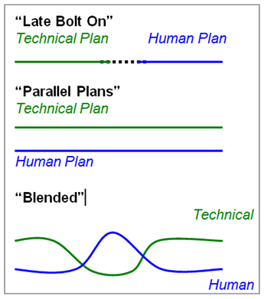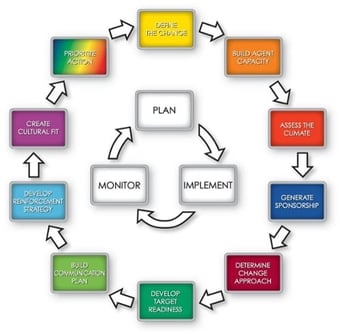Watch This Quick Video Recap:
Whether your organization uses Agile or a more traditional Waterfall approach to project management there is no doubt the end goal is the same. Getting to value realization for every business initiative is, of course, the name of the game. But, while project management protocols focus on delivering projects on time, on budget and to scope, as change management professionals, we know that is not going to be enough. In order to get to full value realization there is more that needs to be done!
of the game. But, while project management protocols focus on delivering projects on time, on budget and to scope, as change management professionals, we know that is not going to be enough. In order to get to full value realization there is more that needs to be done!
In every organizational change project there is going to be something that people are going to need to do differently. These are the behavioral objectives of the change. The truth of the matter is there is no change unless people change their behavior. So, while project management focuses on the technical milestones of a project, change management focuses on the people side.
By integrating change management into project management protocols, project managers will have the tools to manage the human objectives of the change with the same level of rigor as applied to the technical objectives.
The High Price of Not Paying Attention to the People Side of Change
In today’s fast-paced, business world enormous investments are being made in large scale, complex business changes. From new technology to shared services to mergers and acquisitions, the amount of money spent on change last year alone probably reaches the billions of dollars mark. With stakes like these, organizations simply cannot afford to fail.
But, when organizations don’t focus on the people side of a change with the same discipline and rigor as the time frame, budget and scope there will be a huge price to pay. While the change project may not be an out and out failure, value realization will just not be met.
Recent research indicates the costs to organizations are high:
- The Bernard Marr Forbes Blog reports that 25% of technology projects fail outright; 20-25% don’t show any Return on Investment and 50% need massive re-working by the time they’re finished.
- PMI 2016 Research Reports $122 Million is wasted for every $1 Billion USD invested due to poor project performance, which is a 12% increase over 2015.
Yet despite the data, organizations continue to put much more emphasis on the achievement of technical and even business objectives than on the human and cultural elements of changes.
The Blending of Project Management and Change Management
The good news is we are seeing an upward trend of organizations that “get it” when we talk about how change management and project management need to be integrated. But, the truth is, mistakes are still being made.
One mistake we see far too often is when an organization finally decides to utilize a change management process, but they do so as a late “add on” to a project. Their reasoning is usually that they first, want to get to “go-live” then they will start thinking about the people side. We can tell you from experience…that is not going to work.
Another mistake is when change management is handled in parallel, completely separate from the technical objectives of a project. Often, this is when the project team is tasked with the technical objectives and the people side is assigned to the change management or HR team. From our experience, this is another disaster waiting to happen!
 Instead, change management principles, tools, and deliverables need to be blended together with the project management plan from the start. In fact, change management should serve as the central hub in a project management approach beginning with project initiation, and continuing through to plan, execute, monitor and control, and project close.
Instead, change management principles, tools, and deliverables need to be blended together with the project management plan from the start. In fact, change management should serve as the central hub in a project management approach beginning with project initiation, and continuing through to plan, execute, monitor and control, and project close.
If you look at the Accelerating Implementation Methodology’s road map of change management core principles you will see that they surround the project management elements of plan, implement and monitor. AIM was developed so that its deliverables and knowledge areas can be easily inserted at key intersection points in a project management plan.
Here’s the bottom line--there is a need to do something differently if you want a different outcome. Blending project management and change management is most definitely part of the solution for getting to value realization for projects. When the technical side (project management) and the human side (change management) of an initiative are managed concurrently, the chances of full optimization are at their highest.


